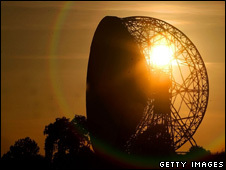
|
| ©Getty Images |
| Jodrell Bank in Cheshire is home to the Lovell Telescope |
The future of Jodrell Bank, one of the world's leading radio astronomy centres, is secure according to the site's owner, Manchester University.
Jodrell's existence had been in doubt because of uncertainty over where money would come from to finish and run its key new project, the eMerlin network.
But the university says funding for the network, which ties together radio dishes across the UK, is now in place.
Jodrell has made many key discoveries and even tracked the Moon landings.
The observatory, famous for its giant Lovell antenna, has been caught up in the budgetary difficulties of the Science and Technology Facilities Council (STFC), which oversees UK physics and astronomy.
'Super-scope'
In seeking to close an £80m hole in its 2009-11 finances, the STFC questioned whether it would be possible to continue funding eMerlin, placing a huge question mark over the future of the project and the Cheshire centre which hosts it.
However, a review process run by the council underlined the scientific significance of eMerlin; and last week, the STFC indicated it would be making a contribution.
In the intervening days, a deal has now been brokered that guarantees full funding for the next two years.
"There is a funding package that goes beyond that and we're still just finalising the details on that; but it's all very positive for the observatory," said Professor Phil Diamond, director of the Jodrell Bank Centre for Astrophysics.
"There will be another of these Programmatic Reviews in two years' time and hopefully it won't be so traumatic as this one; but by then eMerlin will be up and running and we will be in a much stronger position to be looking at full funding. We have to show we are providing data and that we are world class," he told BBC News.
eMerlin is the upgrade to a network of seven radio astronomy stations - from Jodrell and its 76m Lovell Telescope in the North West, to Lords Bridge just outside Cambridge in East Anglia. By linking the stations together using optic-fibre cables, eMerlin can mimic a single super-sensitive radio-telescope spanning 217 km.
Next generation
"eMerlin is the radio astronomy equivalent of the Hubble Space Telescope - it's a 'radio camera'. We observe objects in the nearby Universe - stars being formed, stars dying - out to some of the most distant objects in the Universe," explained Professor Diamond.
"Because of its enormous power, we will be able to see galaxies evolve, from their youth to their old age."
The lessons learned on eMerlin will be fed into the international Square Kilometre Array (SKA) project - a giant next-generation radio telescope, for which Jodrell is leading the development work.
Commenting on the Jodrell announcement, Professor Alan Gilbert, president and vice-chancellor of Manchester University, said: "We are delighted that the STFC has recognised the scientific importance of eMerlin and the Square Kilometre Array, and that they have provided a commitment to fund these important projects, which will guarantee the future of Jodrell Bank."



Reader Comments
to our Newsletter